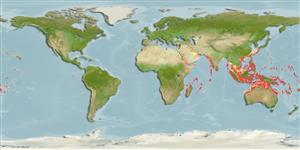Common names from other countries
Environment: milieu / climate zone / depth range / distribution range
Écologie
marin récifal; profondeur 0 - 75 m (Ref. 6773), usually ? - 16 m (Ref. 90102). Tropical; 32°N - 36°S, 29°E - 147°W (Ref. 57375)
Indo-Pacific: Red Sea and East Africa to the Hawaiian and Society islands.
Taille / Poids / Âge
Maturity: Lm ? range ? - ? cm
Max length : 30.0 cm TL mâle / non sexé; (Ref. 559)
Description synthétique
Clés d'identification | Morphologie | Morphométrie
Épines dorsales (Total) : 3; Rayons mous dorsaux (Total) : 12 - 13; Épines anales: 0; Rayons mous anaux: 7 - 8. Color variable; has a black phase with white pectoral ray tips. Bony part of illicium with numerous dark crossbands and nearly twice as long as the 2nd dorsal spine; esca an elongate tuft of flattened appendage.
Inhabit shallow sheltered reefs (Ref. 9710). Adults usually with sponges; juveniles openly on sand or reef, mimicking small sponges or nudibranchs (Ref. 48635). Benthic (Ref. 58302). Oviparous. Eggs are bound in ribbon-like sheath or mass of gelatinous mucus called 'egg raft' or 'veil' (Ref. 6773).
Life cycle and mating behavior
Maturities | Reproduction | Spawnings | Egg(s) | Fecundities | Larves
Oviparous. Eggs are bound in ribbon-like sheath or mass of gelatinous mucus called 'egg raft' or 'veil' (Ref. 6773).
Pietsch, T.W. and D.B. Grobecker, 1987. Frogfishes of the world. Systematics, zoogeography, and behavioral ecology. Stanford University Press, Stanford, California. 420 p. (Ref. 6773)
Statut dans la liste rouge de l'IUCN (Ref. 130435)
CITES (Ref. 128078)
Not Evaluated
Menace pour l'homme
Harmless
Utilisations par l'homme
Pêcheries: sans intérêt
Outils
Articles particuliers
Télécharger en XML
Sources Internet
Estimates based on models
Preferred temperature (Ref.
115969): 25.1 - 29.3, mean 28.3 (based on 3097 cells).
Phylogenetic diversity index (Ref.
82804): PD
50 = 0.5005 [Uniqueness, from 0.5 = low to 2.0 = high].
Bayesian length-weight: a=0.01995 (0.00906 - 0.04395), b=3.01 (2.83 - 3.19), in cm Total Length, based on all LWR estimates for this body shape (Ref.
93245).
Niveau trophique (Ref.
69278): 4.4 ±0.8 se; based on size and trophs of closest relatives
Résilience (Ref.
120179): Haut, temps minimum de doublement de population inférieur à 15 mois (Fec assumed to be > 10,000).
Fishing Vulnerability (Ref.
59153): Low vulnerability (20 of 100).
